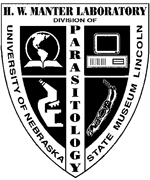Parasitology, Harold W. Manter Laboratory of

Harold W. Manter Laboratory of Parasitology: Library Materials
Document Type
Article
Date of this Version
11-27-2017
Citation
Exp Appl Acarol (2017) 73:493–499 https://doi.org/10.1007/s10493-017-0189-8
Abstract
Rhipicephalus turanicus is an important tick species potentially carrying tickborne pathogens. Several tick species have obvious subspecies divergence. However few studies aimed to examine the existence of divergence within R. turanicus. Therefore, a detailed morphological and molecular analysis was conducted for comparing R. turanicus from the Mediterranean Basin (represented by Albania) and Central Asia (Northwestern China). Altogether 315 adult ticks of R. turanicus (103 from Albania and 212 from China) were morphologically and molecularly analysed. DNA samples were used for mitochondrial 16S rRNA and cox1 gene sequences analysis. In addition, as potentially genetic markers, three fragments including partial nad1-16S rRNA, nad2-cox1, cox1-tRNA-Lys, were designed and then phylogenetically analyzed. Based on detailed morphological observations, only basis capituli length:width ratio (females), the length, the width and the length:width ratio of the scutum (males) had differences between R. turanicus from China and Albania. Gene divergences of 16S rRNA, cox1, partial nad1-16S rRNA, nad2-cox1 and cox1-tRNA-Lys from China and Albania ticks were 3.53–4.84, 3.57–4.92, 3.57–4.07, 3.57–4.39 and 3.18–4.69%, respectively. The evaluated five genetic markers revealed two phylogenetic branches in R. turanicus. Obvious differences exist within R. turanicus based on morphological and genetic analysis. Three newly designed genetic markers (partial nad1-16S rRNA, nad2-cox1 and cox1-tRNA-Lys) in this study may be suitable genetic tools for identification and analysis in R. turanicus. Subspecies analysis of R. turanicus from other regions of the world should be initiated in the future.


Comments
Open access.